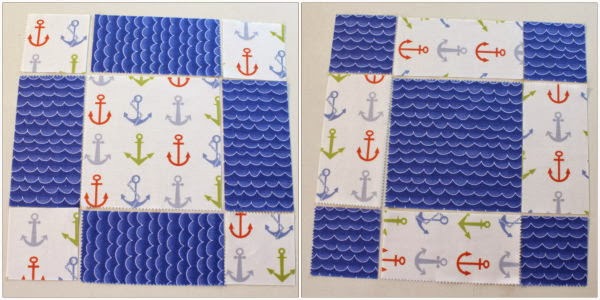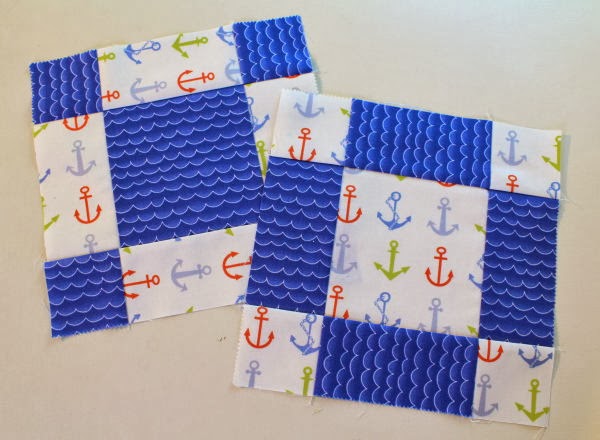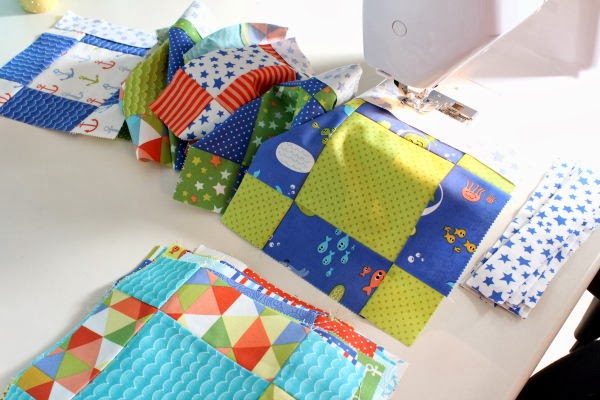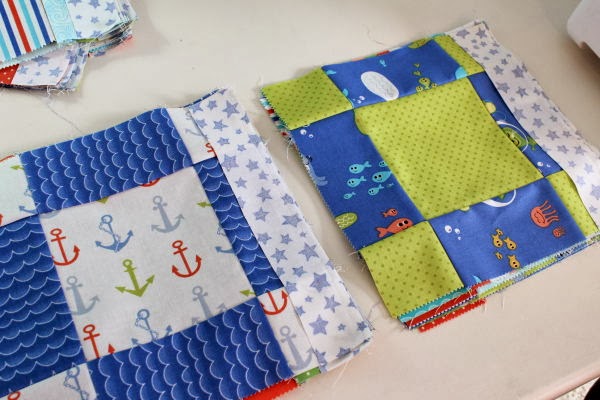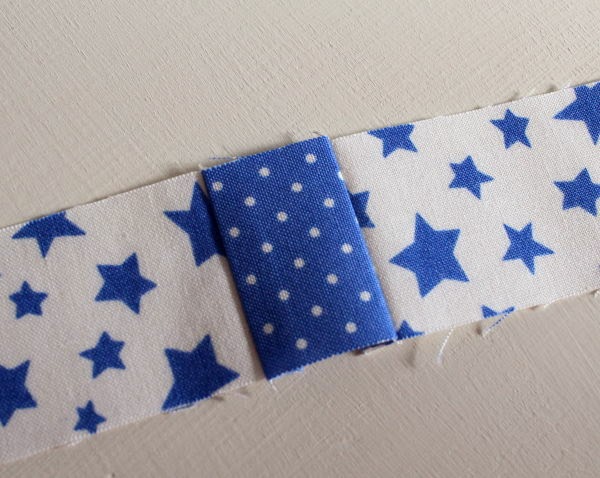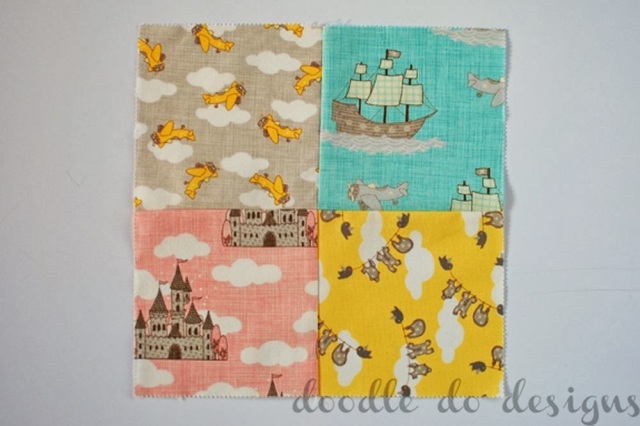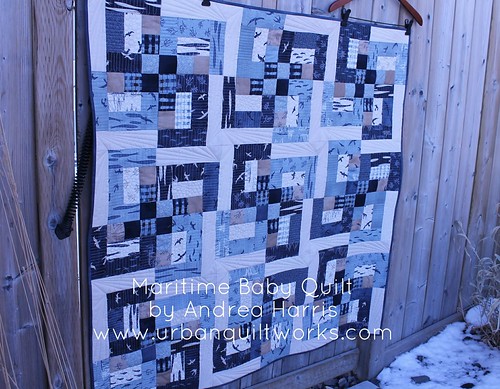
Hi there! It is LeAnne Ballard from Everyday Celebrations with a fun baby quilt for you today. Like many, I absolutely adore the new line April Showers and loved making these two baby quilts. The design is the same for both, appliqued raindrops, but the placement is different for each quilt.
I hope you have fun making this quilt! Check out my other recipes here.

Per Quilt
10 fat quarters*
1 1/2 yards background/neutral fabric
1 1/2 yards backing fabric
1/2 yard binding
2 1/4 yards fuisble webbing (I prefer Heat n’ Bond Lite or you can use your preferred applique method.)
template plastic (Print out raindrop template and trace onto template plastic. Transfer markings from the raindrop onto the template plastic. Cut out template.)
batting
*Note: You could also use jelly roll strips for the scrappy raindrops and fat quarters/fat eighths for the solid raindrops.
Decide whether you want to make the normal or staggered layout:

*All seams are 1/4″ unless noted.
Cutting
From the 1 1/2 background/neutral cut:
{4} 12.5″ x WOF strips
subcut into {4} 10.5″ x 12.5″ rectangles for a total of {16} rectangles
*Note: If you are making the staggered raindrop quilt, trim {4} of the rectangles to 10.5″ x 12.25″. Place these in a separate pile and label. This is the only cutting difference between the quilts.
From each fat quarter cut: the remaining fat quarter will be used for the solid raindrops
{2} 2.5″ x 21″ (or width of the fat quarter) strips
from each strip subcut {1} 9.5″ x 2.5″ and {1} 11.5″ x 2.5″ (I just left the remaining strip. The strip needs to be at least 11.5″.)
Binding
From the 1/2 yard for the binding cut:
{5} 2.5″ x WOF strips
Prepare Applique
Trace {16} raindrops onto the fusible webbing using the raindrop template. Transfer markings onto the fusible webbing. Roughly cut around each raindrop leaving about 1/4″ around each raindrop. Next, cut out the centers of the raindrops leaving about 1/2″. This will help keep the quilt cuddly and soft instead of stiff from the fusible webbing.
Block Assembly
Vertical Raindrops
1. For each vertical raindrop select {4} 2.5″ x 11.5″ strips. Arrange as desired and sew. Press seams OPEN. Make a total of {4} vertical units. (You will have extra of these strips.)
2. Flip the unit over and line up the mark at the bottom with the center seam as shown below. Line up the tip of the raindrop with the same center seam. Quickly fuse in place. (I found it easier to “baste” the fusible web in place by quickly lifting the iron up and down over the webbing. Then I flipped the unit over to the front and fused as directed by my instructions. Otherwise, it was easy to mess up the directions of the seams.)
3. Cut out the raindrop. Leave paper in place until you are ready to fuse in place. Repeat for {4} vertical raindrops.
Horizontal Raindrops
1. For each horizontal raindrop select {5} 2.5″ x 9.5″ strips. Arrange as desired and sew. Press seams open. Make a total of {4} horizontal units.
2. To line up this raindrop, fold the unit in half and lightly press to create a crease. Fuse the webbing in place just like you did for the vertical raindrops, just use the crease as you guide. Repeat for {4} horizontal raindrops.
Solid Raindrops
1. Select {8} of the fat quarters for your solid raindrops. Fuse the raindrop fusible web onto the remaining part of the fat quarter. (Follow the directions for your brand of fusible webbing.)
2. Allow to cool then cut on tracing line. Repeat for {8} solid raindrops.
Patchwork Raindrop
If you opt to make this block, make in place of one of the solid raindrops.
1. From one of the remaining fat quarters cut {1} 4.75″ x 11″ piece and {1} 3.5″ x 11″ piece. From the leftover 2.5″ strips cut {6} 2.5″ squares.
2. Sew together all the 2.5″ squares. Press seams all one direction. Trim unit to measure 11″ long. I just trimmed a little off the top and bottom.
3. Sew the pieces cut from the fat quarter to either side of the patchwork unit. Mine didn’t line up exactly which is fine. It doesn’t have to be perfect.
4. Flip unit over with the patchwork unit to your left. Line up the mark on the raindrop with the seam line running the length of the patchwork unit. Fuse in place and cut raindrop out.
Fuse Raindrops to Background
1. Fold the background rectangles in half lengthwise to create a crease.
2. Remove paper backing and center raindrop onto the rectangle. Raindrop should be about 1.5″ inches from the sides and 1.25″ from the top and bottom. Fuse in place following webbing directions. Repeat for all raindrops.
*For the staggered layout: Adhere {2} of the SOLID and {2} of the VERTICAL raindrops to the slightly smaller (12.25″ x 10.5″) rectangles. These will go in the positions shown below. (Don’t sew the quilt top together yet, this picture just references where the smaller rectangles will go.)

3. Machine stitch around each raindrop to secure in place. This can be done in a variety of ways. You could use a zig-zag, satin, blanket (if your machine has that option), or a simple straight stitch. For my quilts I opted to use a blanket stitch and straight stitch. With the straight stitch, I sewed about 1/4″ away from the edge of the raindrop. Note if you choose to use a straight stitch, the raw edges will fray and wear over time. This step is easiest to do BEFORE you sew the quilt top together.
Quilt Assembly
For the regular layout:
1. Arrange the quilt units in {4} rows of {4} as shown below.
2. Sew units together in rows and press seams one direction, alternating from row to row. Then sew rows together. Press seams one direction. Press entire quilt top.
For the staggered layout:
3. Cut 2 of the SOLID raindrops in half, NOT the slightly smaller ones. Cut the unit in half to make {2} 6.25″ x 10.5″ units. These will go in the positions below:

4. Sew units together in rows and press seams one direction, alternating from row to row. Then sew rows together. Press seams one direction. Press entire quilt top.
5. Then baste, quilt, and bind!

one 40″ x 48″ baby quilt
LeAnne Ballard

![]()

















































